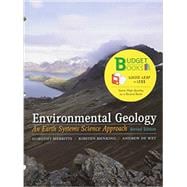
Note: Supplemental materials are not guaranteed with Rental or Used book purchases.
Purchase Benefits
Looking to rent a book? Rent Loose-leaf Version for Environmental Geology [ISBN: 9781464156571] for the semester, quarter, and short term or search our site for other textbooks by Merritts, Dorothy; Menking, Kirsten; DeWet, Andrew. Renting a textbook can save you up to 90% from the cost of buying.
Kirsten Menking is an environmental Earth scientist in the Department of Earth Science and Geography at Vassar College. Her research interests include using lake sediments to unravel Earth’s history of climatic change, linking this history to atmospheric and hydrologic processes through a combination of numerical modeling experiments and collection of weather and stream discharge data, analyzing the evolution of landforms in response to climatic and tectonic processes, and studying the impacts of urbanization on streams. She has published journal articles documenting glacial–interglacial cycles in the Sierra Nevada mountains and adjacent Owens Valley of California, determined the climatic conditions necessary to produce a Pleistocene lake in the now-dry Estancia Basin of New Mexico, and un-covered a centuries-long mid-Holocene drought in New York’s Hudson River valley. Her current research involves quantifying the amount of road salt entering the groundwater system,a topic of concern both for people dependent on well water and for aquatic ecosystems.
The New copy of this book will include any supplemental materials advertised. Please check the title of the book to determine if it should include any access cards, study guides, lab manuals, CDs, etc.
The Used, Rental and eBook copies of this book are not guaranteed to include any supplemental materials. Typically, only the book itself is included. This is true even if the title states it includes any access cards, study guides, lab manuals, CDs, etc.